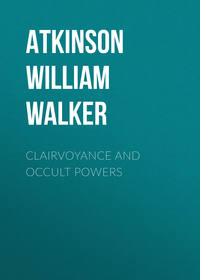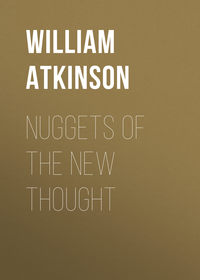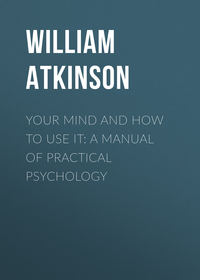 полная версия
полная версияGenuine Mediumship; or, The Invisible Powers
The World of Sensation
The reports of our sense organs are called "sensations." A sensation is defined as "an impression, or the consciousness of an impression, made upon the mind through the medium of a nerve or one of the organs of sense. The term 'sense' is defined as 'a faculty possessed by animals of perceiving external objects by means of impressions made upon certain organs of the body, or of perceiving changes in the condition of the body.' Our senses have been well said to constitute 'the doors to the outside world.' Unless our attention is specially directed to the subject, few of us even begin to realize how completely we are dependent upon these 'doors' to the outside world" for our knowledge of that outside world. It is only when we stop to imagine how completely shut in, or shut out, we would be if all of our sense channels should be destroyed, that we can even begin to realize just how dependent we are upon our senses for our knowledge of the world in which we live, and move, and have our being.
A Senseless World
A writer on the subject has said: "Psychologists have pointed out to us the fact that if a human being were born without sense organs, no matter how perfect a brain he might have, his life would be little more than that of a plant. Such a person would exist merely in a dreamlike state, with only the very faintest manifestations of consciousness. His consciousness would not be able to react in response to the impact of sensations from the outside world, for there would be no such impact. And as consciousness depends almost entirely upon the impact of, or resistance to, outside impressions, his consciousness would be almost entirely inactive. He would be conscious of his own existence, but would probably never realize the fact fully, for he would have nothing else with which to compare himself, and his self-consciousness would never be aroused by contact with things outside of himself. Such a person would not have even the memories of previous sensations or experiences to arouse or heighten his consciousness or thought, and consequently he would have no imagination to use. He would be, to all intents and purposes, a living corpse. Helen Keller has only two doors of sensation closed to her—the sense of sight and the sense of hearing. Touch, taste, and smell, however were left to her; and each was quickened and heightened in order to help so far as possible to perform the world of the defective senses. The reaching of the consciousness of this girl is considered by science to be akin to a miracle—yet only two senses were missing. To appreciate the full meaning of the importance of the senses, one has but to think of Helen Keller as having been also deprived of the sense of touch."
The Elemental Sense
Science informs us that all of the five senses of man, viz., the respective senses of touch, sight, hearing, taste, and smell are but modifications of one elementary sense namely the sense of touch; and that the other senses have been gradually evolved from that one elementary sense. This is seen to be the case when it is realized that the only way that we "sense" the presence of an outside object—be that object either a material substance, a vibration of the air, or an etheric vibration of light—is by that outside object coming in contact, directly or indirectly, with one or more of our sensory nerves, the latter conveying the report of the contact to the brain, which translates the sensation into what is called a "perception." This is true of the sensations of touch, sight, hearing, taste, and smell, and of senses higher than these and which as yet are not recognized by science. Consequently, the consciousness of the presence of an outside thing arises from contact with that outside thing through the channel of the sense of touch, or of some of its more complex evolved phases.
The Raw Material of Thought
From what has been said, it is seen that we can know only those things concerning the outside world which are capable of being reported to us by means of sense impressions, simple or complex—all of our thought regarding the world is made up from "the raw materials of thought" which psychologists have termed sensations. Consequently, if an individual is deprived of one or more of his ordinary senses, his knowledge of the outside world is decreased to just that extent. And, likewise, if the individual were to be given one or more additional senses, his knowledge of the world would be increased in the same ratio. The same result, at least in a certain degree, would be attained if the existing senses of the individual were to be increased in power so as to register higher rates of vibration than they now consciously register and record.
The Evolution of the Senses
This subject of increased sense-powers has always been a fascinating one for the psychologists, and much speculation has been indulged in concerning the increased consciousness of mankind were additional senses opened to it. We ask you to carefully consider the following quotations from psychologists possessing the "scientific imagination."
A psychologist says: "All the senses have been evolved from the elementary sense of Touch. All of our senses are but modified, specialized, and more complex forms of the sense of Touch. The elementary life-forms possessed merely the sense of Touch; and that but faintly developed—but a faint sensitiveness to outside impressions. Then developed the sense of Taste, from which later evolved the sense of Smell, the latter even now being closely associated with the former. Then evolved the sense of Hearing, or the consciousness of the contact of air vibrations called 'sound.' Then evolved the sense of sight, or the consciousness of contact with the light waves of the other. And it is not impossible, or even improbable, that the human race will eventually develop other and more complex senses—in fact, many even now claim that the development of extra senses is now under way in the race, and that the same are now manifesting the presence and their powers in exceptional cases."
Unfoldment of New Senses
The same writer continues as follows: "Even as it is man is able to perceive only a limited number of sound vibrations—there are many sound vibrations above and below his scale, and which he is unable to perceive, but which are registered by delicate instruments. Likewise, man is able to perceive only a limited range of light vibrations, there being enormous fields of such vibrations above and below his range. Again, man is unable to sense electrical waves, or magnetic waves—though, theoretically, he should be able to sense these as well as light waves, the difference between these respective fields of etheric vibrations being simply different rates of vibration. Imagine what a new world would be opened to man if he could sense the waves of electricity. In that case he could 'see' things as far away from him as the waves of electricity could travel, and even though solid objects intervened, as in the case of the X-Rays. In such a case a man might actually 'see' things at the other side of the world, by means of 'wireless electrical waves.' Theoretically these things are possible, providing that man's optical nerves are rendered more sensitive, or provided that he evolves a new set of sensory nerves and instruments of impression."
Discovery of New Worlds
Another psychologist says: "If a new sense or two were added to the present normal number in man, that which is now the phenomenal world for all of us might, for all that we know, burst into something amazingly different and wider, in consequence of the additional revelations of these new senses." Another authority has said: "It does not seem at all improbable that there are properties of matter of which none of our senses can take immediate cognizance, and which other beings might be able to see in the same manner that we are sensible to light, sound, etc." Another writer has said: "We know that our sensory nerves are capable of transmitting to the brain only a part of the phenomena of the universe. Our senses give us only a section of the world's phenomena. Our senses usher only certain phenomena into the presence of our minds. If we had three or four new senses added, this might appear like a new world to us; we might become conscious of a vast number of phenomena which at present never have any effect upon our nervous system. It is not possible to imagine a race of beings whose senses do not resemble ours, inhabiting other worlds."
Transcendental Senses
Another writer has drawn an interesting picture, which is based upon a conjecture which is scientifically valid, as follows: "The late Professor James once suggested as a useful exercise for young students a consideration of the changes which would be worked in our ordinary world if the various branches of our receiving instruments happened to exchange duties; if, for instance, we heard all colors, and saw all sounds. All this is less mad than it seems. Music is but an interpretation of certain vibrations undertaken by the ear; and color is but an interpretation of other vibrations undertaken by the eye. Were such an alteration of our senses to take place, the world would still be sending us the same messages, but we should be interpreting them differently. Beauty would still be ours, though speaking in another tongue. The birds' song would then strike our retina as pageant of color; we should see all the magical tones of the wind, hear as a great fugue the repeated and harmonized greens of the forest, the cadences of stormy skies. Did we realize how slight an adjustment of our own organs is needed to initiate us into such a world, we should perhaps be less contemptuous of those mystics who tell us in moments of transcendental consciousness they 'heard flowers that sounded, and saw notes that shone'; or that they have experienced rare moments of consciousness in which the senses were fused organs is needed to initiate us into such a world into a single and ineffable act of perception, in which color and sound were known as aspects of the same thing."
We Sense Only Vibratory Motion
In assimilating the strange and wonderful conceptions of the psychologists above quoted, concerning the possibility of a new world of sensation arising from the possession of new channels of sense impression, we must never lose sight of the basic fact that all sensations result from contact with vibratory motion. An eminent scientific authority has said regarding this: "The only way the external world affects the nervous system is by means of vibratory motion. Light is vibratory motion; Sound is vibratory motion; Heat is vibratory motion; Touch is vibratory motion; Taste and Smell are vibratory motion. The world is known to us simply by virtue of, and in relation to, the vibratory motion of its particles. Those vibratory motions are appreciated and continued by the nervous system, and by it brought at length to the mind's perception."
The Higher Planes of Nature
In view of the facts and principles above set forth and considered, we may begin to see that there is nothing "unnatural" in the hypothesis that there may be reports conveyed to the consciousness of man by means of higher vibrations than those of ordinary sound, or ordinary sight, providing that man has either (1) highly developed his ordinary senses of sight, hearing, or touch to a degree sufficiently high to register these higher vibrations; or else has evolved and unfolded into consciousness certain latent faculties of sense-impression which are lying dormant in the great masses of mankind. In fact, the thoughtful person will be forced to admit that this new knowledge of the nature of sensations, and of its relation to vibratory motion, renders extremely probable the truth of the great body of reports of such so-called extra-conscious knowledge which the experience of the race has furnished from the beginning of human history down to the present time. Such a person will see that it is not a sign of "credulity" for a person to accept such reports, so universally set forth; but that, rather, it is a sign of "credulity" for a person to accept blindly the dogmatic assertions of the materialistic sceptics to the effect that "there is no such thing possible in the natural world, under natural world, under natural laws—the whole thing is delusion or else deliberate fraud." Such "know-it-all" persons are usually found to really "know much that is not true," and to lack knowledge of much that is true, regarding Nature, her realm and her laws.
An Appeal To Reason
Concluding these statements, let us say that the student of this book will find nothing contained within this book which is contrary to Nature's laws and principles. He will nowhere in it be asked to suspend the exercise of his reason, and to accept as facts things which violate all of Nature's laws. Instead, he will find at each point full natural explanations of even the most wonderful phenomena; and the appeal to accept same will be made always to his reason, and not to his blind faith or unreasoning belief. The student is urged to build his knowledge of this important subject upon this solid rock of natural law and fact, and not upon the shifting and sinking sands of mere dogmatic assertion and appeal to assumed authority ancient or modern.
PART II
Mental Vibrations and Transmissions
In the category of Nature's Finer Forces must be included that class of manifestations which are generally known as Telepathy, Thought Transference, Thought Force, etc., all of which are based upon the fact that there is present in all such mental states as Thought, Emotion, Desire, etc., a certain rate of vibratory motion, which motion is capable of being radiated from the mind of the person manifesting them in such power and force that they may be registered with more or less distinctness upon the minds of other persons are at a greater or less distance from the first person. In the more common forms of its manifestation, such mental force or power is known as Thought Force, Mental Influence, etc., and in its more pronounced and less common phases it is known as Telepathy, Thought Transference, etc., but the basic principle is precisely the same in all of such cases, simple or complex though their manifestations may be.
The Higher Forces
We may say here, frankly and plainly, however, that the advanced occultists regard this class of phenomena as comparatively simple and elementary, and therefore not fully entitled to be included in the same category with the higher phases of Nature's Finer Forces, such as, for instance, Clairvoyance, Psychometry, Communication with the Higher Planes, etc. But notwithstanding this, we are of the opinion that any and every one of the finer forces of nature, i.e., any of the forces which are over and above the plane upon which the ordinary senses of man, normally developed, ordinarily function and operate, should be placed in one general category of the Higher Forces of Nature, particularly in a work of this kind designed for the instruction of the general public upon these important subjects. Accordingly, these lesser manifestations of the finer forces in the natural world shall be carefully considered in this part of this book, so that the student may become acquainted with the scientific principles upon which they are based, and may be enabled to develop the power of manifesting such powers if he choose to do so; and that he may understand the nature of such forces and powers when they are manifested by other persons.
Chitta, or Mind Substance
The Hindu Teachings hold that that which we call "Mind" is not an intangible something different from anything else in Nature, but that, on the contrary, it forms a part of Nature's general manifestation, and is a substantial thing. The Hindus have given to this Mind Substance the name of Chitta. Without going into metaphysical discussion, or entering into technical details concerning this Mind Substance or Chitta, we may say that the Hindus believe it to be one phase of the great Manifestation which we call Nature—just as that which we call Matter is another phase of Manifestation—and, like Matter, having its own particular kind of force, or energy, its own rates of vibrations, and its own attribute of radiating its vibratory force or energy over space. Chitta manifests its activity in creating Thought, Emotions, etc., and also in receiving impressions from the outside world which it translates into perceptions and ideals. Chitta, or Mind Substance, is not regarded by the Hindus as being identical with the Soul, or the Ego; but, on the contrary, they regard it as being an instrument for the expression of the activity of the Ego, or Soul, just as the Body is another kind of instrument. Both Body and Mind are regarded as being intended for the use of the Ego or Soul, and not as identical with the latter. We shall not discuss these distinctions further in this book, this subject being apart from the general field and scope of the present work.
What Modern Science Says
There are many to whom this conception of the vibration energy of Chitta or Mind Substance may seem strange. But such persons will be still more surprised, perhaps, when they are told that modern science has practically admitted the general truth contained in the Hindu teachings concerning the same, though modern science seems to cloak the facts of the case in technical terms so that the ordinary person is unable to comprehend the real facts dwelling beneath these terms. To this latter class we specially commend the following statement made by Professor Ochorowicz, the eminent European scientist, a few years ago. Professor Ochoriwicz says:
A Living Dynamic Focus
"Every living being is a dynamic focus. A dynamic focus tends ever to propagate the motion that is proper to it. Propagated motion becomes transformed according to the medium it traverses. Motion always tends to propagate itself. Therefore, when we see work of any kind—mechanical, electrical, nervic, or psychic—disappear without visible effort, then of two things, one happens, namely, either a transmission or a transformation. Where does the first end, and where does the second begin? In an identical medium there is only transmission; in a different medium there is transformation.
"You send an electric current through a thick wire. You have the current, but you do not perceive any other force. But cut that thick wire, and connect the ends by means of a fine wire, and this fine wire will grow hot—there will be a transformation of a part of the current into heat. Take a pretty strong current, and interpose a wire still more resistant, or a very thin carbon rod, and the carbon will emit light. A part of the current, then, is transformed into heat and light. The light acts in every direction around about, first visibly as light, then invisibly as heat and electric current. Hold a magnet near it. If the magnet is weak and movable, in the form of a magnetic needle, the beam of light will cause it to deviate; if it is strong and immovable, it will in turn cause the beam of light to deviate. And all this from a distance, without contact, without special conductors.
Dynamic Correlate of Thought
"A process that is at once chemical, physical and psychical, goes on in the brain. A complex action of this kind is propagated through the gray brain matter, as waves are propagated in water. Regarded on its physiological side, an idea is only a vibration, a vibration that is propagated, yet which does not pass out of the medium in which it can exist as such. It is propagated only as far as other vibrations allow. It is propagated more widely if it assumes the character which subjectively we call emotive. But it cannot go beyond without being transformed. Nevertheless, like force in general, it cannot remain in isolation, and it escapes in disguise.
"Thought stays at home, as the chemical action of a battery remains in the battery; it is represented by its dynamic correlate, called in the case of the battery a 'current,' and in the case of the brain, I know not what; but whatever its name may be, it is the dynamic correlate of thought. I have chosen the name 'dynamic correlate.' There is something more than that; the universe is neither dead nor void.
"A force that is transmitted meets other forces, and if it is transformed only little by little it usually limits itself to modifying another force at its own cost, though without suffering materially thereby. This is the case particularly with forces that are persistent, concentrated, well seconded by their medium. It is the case with the physiological equilibrium, nervic force, psychic force, ideas, emotions, tendencies. These modify environing forces, without themselves disappearing. They are imperceptibly transformed, and if the next man is of a nature exceptionally well adapted to them, they gain in inductive action."
Answer to Skeptical Critics
The two most likely objections advanced against this conception by sceptical critics are as follows: "(1) The mental vibratory motion, or vibratory waves, are not known to science, nor recorded on scientific instruments such as the galvanometer. What is the rate of such vibrations, and what is their general character? (2) Granted the existence of such vibratory energy, or thought-waves, how and by means of what channel does the second person receive them from the first person? How are they registered or recorded?" These objections are capable of being met in a scientific manner, to the satisfaction of any fair-minded critic or investigator. We shall now give you, briefly, the gist of the answer of science to the aforesaid objections.
The World of Vibrations
It is true that the scientific instruments of the laboratory, such as the galvanometer, do not record thought vibrations. This, because such instruments are capable of registering and recording on certain rates and modes of vibratory energy. Thought vibrations are registered only by their appropriate instruments, namely, the Chitta of Mind substance of living persons. As to the "general character and rate of vibration" of these waves of mental force, we can only say that their general character is that of "mental force" as opposed to "physical force."
As to their rate of vibration, we can only say that this is not precisely known, not having as yet been definitely ascertained; but it should be added that there is plenty room for these vibrations in the great field of vibratory energy. Read the following paragraphs, and decide this last matter for yourself.
Uncharted Seas of Vibration
The following quotations from eminent scientists will serve to give the student a general idea of the views of science upon the question of the possibility of the existence and presence of vibratory energy of kinds and characters as yet unknown to science:
The first scientist says: "There is much food for speculation in the thought that there exists sound waves that no human ear can hear, and color waves that no eye can see. The long, dark, soundless space between 40,000 and 400,000,000,000,000 vibrations per second, and the infinity of range beyond 700,000,000,000,000 vibrations per second, where light ceases, in the universe of motion, makes it possible to indulge in speculation." The second scientist says: "There is no gradation between the most rapid undulations or tremblings that produce our sensation of sound, and the lowest of those which give rise to our sensations of gentlest warmth. There is a huge gap between them, wide enough to include another world of motion, all lying between our world of sound and our world of heat and light. And there is no good reason whatever for supposing that matter is incapable of such intermediate activity, or that such activity may not give rise to intermediate sensations, provided that there are organs for taking up and sensifying these movements."











